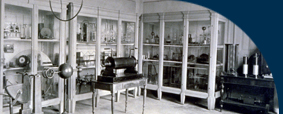 |
Ampère's apparatus |
 |
Banco di Ampère |
| Subject: electromagnetism/electrodynamic action among mobile circuits with flowing current |
Settore: elettromagnetismo/azioni elettrodinamiche tra circuiti mobili percorsi da correnti |
| Number of catalogue: 254 |
Numero di inventario: 254 |
| Engraved on the mahogany base: "Secretan à Paris" |
Sulla base di mogano: "Secretan a Paris" [inciso] |
| 1865 [document] |
Periodo di costruzione: 1865 [documento] |
| Mahogany, brass, copper |
Materiali utilizzati: Mogano, ottone, rame |
300 X 200 X 405 [mm] |
Dimensioni: 300 x 200 x 405 [mm] |
| |
|
The historical origin of this instrument is linked to the discovery, made in 1820 by the Danish physicist Hans Christian Oersted (1777-1851). He observed that a wire through which current passes influenced the motion of a magnetic needle placed near it. Based upon this discovery, the French physicist André-Marie Ampère (1775-1836), in a short time and at a frenzied pace, carried out a number of famous and brilliant experiments in which he reversed the first speculative interpretations of the phenomenon. This had been interpreted in the framework of the Romantic "Naturphilosophie" in terms of "electric conflict". In order to make those experiments he used a device he had created, which demonstrated the mutual interaction of currents passing in mobile circuits of varying forms. In February 1821 Ampère had already commissioned the famous mechanician Nicolas Costant Pixii (1776-1861) to build his famous "banco", which was equipped with several accessories. The results of his experimental work carried out between the end of 1820 and the year 1825 were codified in the famous memoir [1] of 1827 in which he supplied a complete mathematical theory of the electrodynamic interactions that were related to Newton's central forces. He also unfolded his famous hypothesis on the electric origin of magnetic forces.
|
Storicamente questo pezzo ebbe origine dalla scoperta, avvenuta nel 1820, del fisico danese Hans Christian Oersted (1777-1851), secondo cui un filo percorso da corrente influenzava il moto di un ago magnetico posto nelle sue vicinanze. Partendo da tale fatto, il fisico francese André-Marie Ampère (1775-1836), in breve tempo e con un'attività frenetica, realizzò una serie di celebri e brillanti esperienze sperimentali in cui ribaltava le prime interpretazioni speculative del fenomeno, formatesi nell'ambiente della "Naturphilosophie" romantica in termini di "conflitto elettrico". Per realizzarle si servì di un apparato da lui stesso inventato che mostrava l'interazione reciproca di correnti passanti in circuiti mobili di varia forma. Già nel febbraio del 1821 Ampère aveva fatto costruire il suo famoso "banco", corredato da numerosi accessori, dal celebre meccanico Nicolas Costant Pixii (1776-1861). I frutti del suo lavoro sperimentale intrapreso tra la fine del 1820 e il 1825 furono codificati nella famosa memoria [1] del 1827 in cui egli forniva una completa teoria matematica delle interazioni elettrodinamiche ricondotte a forze centrali newtoniane ed esplicava la sua famosa ipotesi sull'origine elettrica delle forze magnetiche. |
| |
|
Description: A mahogany base with four feet supporting two brass columns, each of which has two brass sheets, placed horizontally one upon the other and which terminate with two containers for mercury. A pair of screw rheophores, which are placed at the base of the two brass columns, electrically supplies the mercury tanks. The "banco" is provided with four mobile copper circuits of varying forms , and each of them is able to rotate freely on a pair of points that are immersed in the mercury tanks. |
Descrizione: una base in mogano con quattro piedini sostiene due colonne d'ottone, ciascuna recante orizzontalmente due lastre in ottone allineate l'una sopra l'altra e terminanti con due vaschette per il mercurio. Una coppia di serrafili a vite, posizionati alla base delle due colonne d'ottone, provvede ad alimentare elettricamente i pozzetti di mercurio. Il banco è provvisto di quattro circuiti mobili in rame di varia forma, ciascuno in grado di ruotare liberamente su una coppia di punte che pescano nel mercurio dei pozzetti. |
| |
|
Function: By connecting the rheophores with the terminals of an electric pile, the "banco" permits the highlighting of the electrodynamic action among mobile circuits with flowing current or the mutual action of parts of the same circuit. The device, which was originally provided with additional metal circuits, presently has a pair of rectangular frames, an astatic frame (which is not subject to the action of the earth's magnetic field) and a solenoid, which is able to orientate itself, when electric current flows, in the direction of the earth's magnetic field. |
Funzionamento: collegando i serrafili con gli estremi di una pila elettrica, il banco permette di evidenziare le azioni elettrodinamiche tra circuiti mobili percorsi da corrente o l'azione reciproca di parti di uno stesso circuito. L'apparecchio, che originariamente era dotato di un più ricco numero di circuiti metallici, ha oggi una coppia di telai rettangolari, un telaio astatico (che si sottrae all'azione direttice della terra) ed un solenoide in grado di orientarsi, al passaggio della corrente elettrica, nella direzione del campo magnetico terrestre. |
| |
|
Bibliography: Marco [1883], vol. II, pp. 204-205, 211-213; Mantovani [1994], pp. 56-57. |
Bibliografia: Marco [1883], Vol. II, pp. 204-205; 211-213; Mantovani [1994], pp. 56-57. |
| |
|
[1] "Mémoire sur la théorie mathématique de phénomènes électrodynamiques uniquement déduite de l'experience" Paris 1827. The memoire had been published by Ampère at his own expense already in 1826 but it drew more attention when it was included in the proceedings of the Académie in 1827. |
[1] "Mémoire sur la théorie mathématique de phénomènes électrodynamiques uniquement déduite de l'expérience" Paris 1827. In realtà la memoria fu pubblicata da Ampère a proprie spese già nel 1826 ma ebbe una risonanza più vasta quando fu inserita nel '27 negli Atti dell'Académie. |

